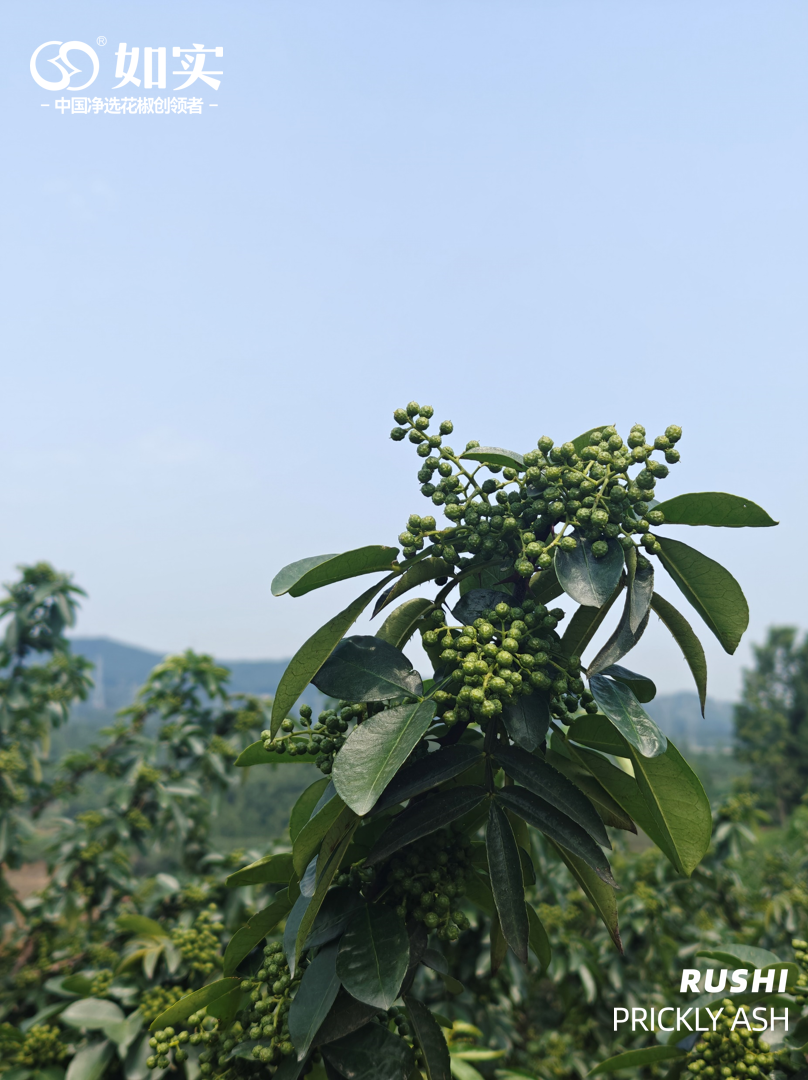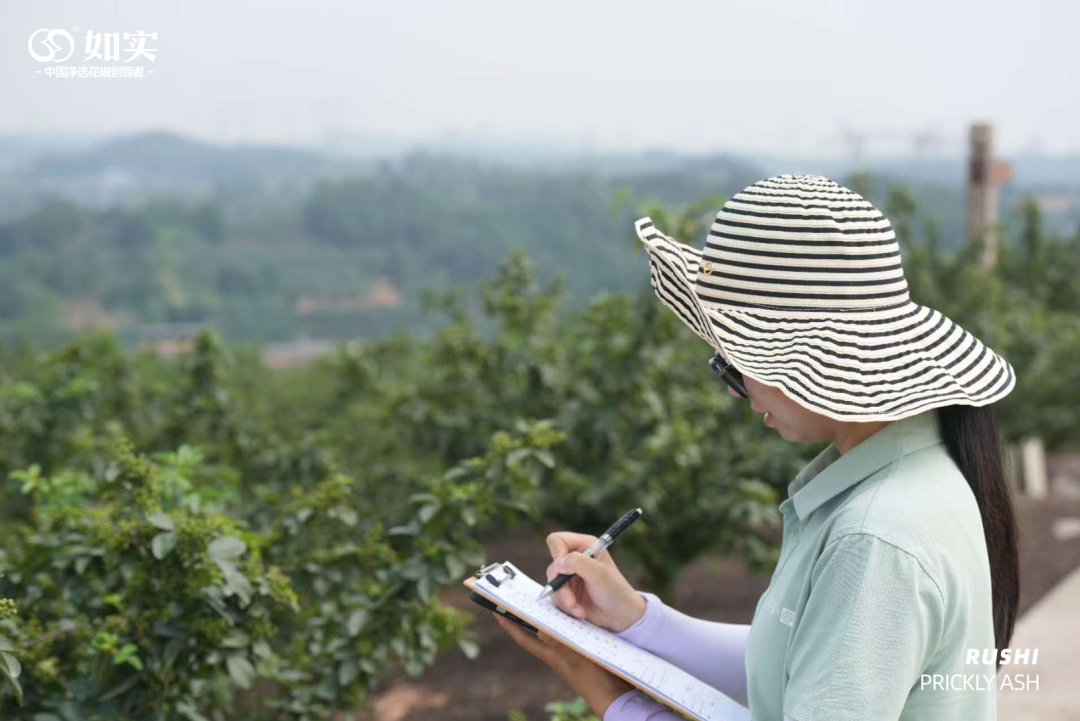2025 Rattan Pepper Report|Full-Chain Risk Control & Rushi’s Source-Level Food Safety
In June 2025, the Rushi inspection team conducted an in-depth visit to rattan pepper harvesting bases. The investigation focused on planting, primary processing, and storage practices to evaluate the food safety level of rattan pepper raw materials.
From 2024 to 2025, due to low market prices, an increasing number of farmers abandoned rattan pepper cultivation. This year, the weather has been dry; except for a few well-managed bases with unaffected yields, most areas experienced a decline in production. The total output is estimated to have decreased by about 40% compared to 2024.
Basic Overview of Rattan Pepper
Rattan pepper (Zanthoxylum armatum DC) gets its name from its vine-like branches. It belongs to the Rutaceae family and is widely distributed in the Sichuan Basin and surrounding hilly regions, including most of Chongqing. In cultivation, the plant shape has been modified, and the vine-like appearance is now less obvious. It is mainly found in Sichuan Province, Chongqing Municipality, and Guizhou Province.
Plant morphology: Rattan pepper is a small shrub with gray-brown branches bearing short spines. The leaves are oval or lanceolate with serrated edges and glandular dots between the teeth. The upper surface is green and the underside is pale green with scattered oil spots.
Sensory description: The fruit is a follicle that naturally splits along the suture line when mature, releasing the seed. The pericarp ranges from light green to emerald green and is densely covered with oil glands containing transparent volatile oil.
Aromatic components: Mainly composed of terpenes, alcohols, aldehydes, ketones, esters, and olefins. The varying contents of these compounds create the unique fresh aroma of rattan pepper.
Numbing components: Primarily hydroxy-α-sanshool, hydroxy-β-sanshool, and hydroxy-γ-sanshool. The numbness intensity of rattan pepper is generally lower than that of red Sichuan pepper, and its fresh aroma makes it more acceptable to people not accustomed to the numbing sensation.
Rattan Pepper Cultivation Overview
Main production areas: Sichuan Basin, most of Chongqing, and Guizhou Province
Altitude: 300–800 meters
Topography: Found in plains, hills, and mountainous areas
Soil: Most types are suitable, but good irrigation and drainage are necessary
Climate: Subtropical humid climate; rattan pepper prefers water and fertilizer but is not flood-tolerant
Seed propagation: Fully mature seeds are sown in autumn and transplanted the following year after being potted
Grafted seedlings: High-quality scions are grafted onto rootstocks; these yield earlier and more abundantly but cost more
Transplanting: Seedlings with healthy root systems are transplanted into fields
Planting density: 2–3.5 meters between plants; 3–4 meters between rows
Fertilization & Irrigation
Frequency: 3–4 times/year
Types: Compound fertilizer, organic fertilizer
Application methods: Broadcasting, trench application, integrated water-fertilizer systems
Fertilizer dosage: About 1–1.5 kg/tree/year; 7.5 kg organic fertilizer/tree/year
Irrigation: Most bases are equipped with sprinkler systems or hoses; most farmers rely on rainfall
Pest & Disease Control
Most rely on chemical control methods, supplemented by green control techniques such as insecticidal lamps, yellow sticky traps, and biopesticides.
Common pesticides:
Insecticides: Imidacloprid, acetamiprid, lambda-cyhalothrin, propargite, cyflumetofen
Fungicides: Tebuconazole, mancozeb, propineb, prochloraz, difenoconazole, pyraclostrobin
Application methods: Spraying using manual sprayers, drones, or high-pressure systems
Harvesting
Harvesting time: Early June to mid-July
Harvesting method: Mainly harvested with branches
Cut entire fruit-bearing branches, leaving 3–5 cm
Further cut the branches into 40–60 cm sections and load into plastic crates
Transport to drying plants for processing
Harvesting condition: Must not be conducted in rainy weather
Processing and Storage
Loading: Harvested branches are evenly loaded into drying chambers via conveyor belts. Loading quality affects drying results.
Withering (blowing): Run blowers only without heat for 4–8 hours based on moisture level, then gradually increase temperature.
Gradual temperature rise: Drying temperature increases over time, generally not exceeding 48°C. Drying lasts 36–48 hours.
Discharge: After drying, materials are separated by hand or conveyor belts into fruit, seeds, and leaves.
Primary Processing & Storage
Initial screening at origin:
Drum threshing: Uses a threshing machine to separate pericarp from branches, leaves, and some seeds
Air separation & screening: Removes seeds, spines, broken leaves, and fruit stems
Storage:
Conditions: Cold storage at 0–5°C, dry and ventilated to prevent pests, rodents, and moisture
Packaging: Woven bags + inner liners
Trading:
Buyers purchase directly from large growers
Smallholders either entrust sales to large growers or sell at local markets
Comprehensive Food Safety Risk Assessment
According to the Food Safety Assessment Work Guide issued by the China National Center for Food Safety Risk Assessment, Rushi conducted a full safety risk analysis on rattan pepper based on actual production conditions.
Traceability risk:
Base-sourced peppers are traceable to specific growers
Smallholder-sourced peppers are from scattered sources, difficult to trace
Pesticide residue risk:
Bases adopt regulated pesticide usage with records
Due to low market prices, smallholders reduced costs, but pesticide use has improved recently
Primary processing risk:
Bases use electricity, natural gas, or methanol — clean energy sources
Some smallholders or traders still use coal, which introduces risks such as foreign matter (snails, hair, stones, coal dust), and chemical pollutants (benzo[a]pyrene from long-term heating and SO₂ from coal combustion)
Storage risk:
Bases store in cold storage using lined woven bags
Smallholders store in plastic or unlined woven bags at ambient temperature, posing risks of plasticizer contamination and loss of volatile compounds
What Does Rushi Do About Pesticide and Processing Risks?
1. Early-stage regional survey
During early harvest season, organize personnel to visit production areas for sampling, testing, and quality screening, and archive all records
Promote advanced agronomy: guide bases to adopt low-toxicity pesticides, install pest control devices, and increase organic fertilizer use while reducing chemical input
2. Raw material sampling & testing
Upon arrival at the factory, each batch is sampled according to GB/T 12729.2-2020 (Spices and Seasonings - Sampling Method)
Tests are recorded in the system and feedback is provided to partner bases
Non-compliant materials are rejected
3. Storage
Categorized storage: separate by batch to avoid cross-contamination and maintain flavor integrity
Cold storage at -10 to 0°C helps reduce oxidation and aroma loss, ensuring stable quality
4. Regular quality checks
Conduct regular inspections of sensory qualities and key physical-chemical indicators such as volatile oils and sanshool compounds
Conclusion:
Through this field investigation, rattan pepper from Rushi’s managed bases demonstrates food safety across the entire process and is assessed as safe. Smallholder-sourced peppers, due to their complex origins and weaker controls, are assessed as relatively safe.
As rural labor decreases and manual costs rise, bases are exploring new planting models — such as drone transportation, more scientific pest control, and reuse of post-processing by-products — to reduce labor costs and improve competitiveness.
Overall, in the 2024–2025 season, low prices led to increased abandoned acreage. Combined with drought, all but a few well-managed bases experienced reduced yields. The total production volume is estimated to be 40% lower than in 2024.





